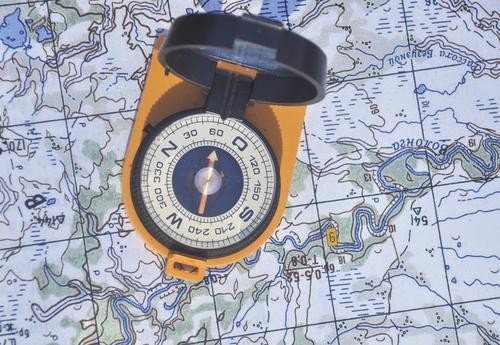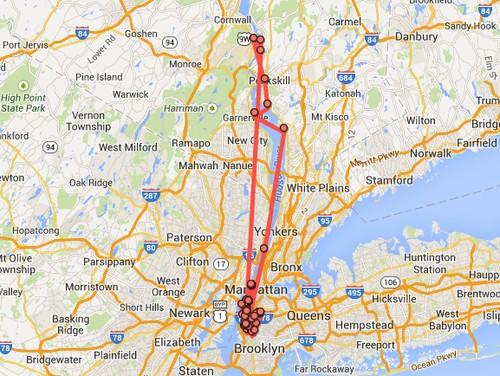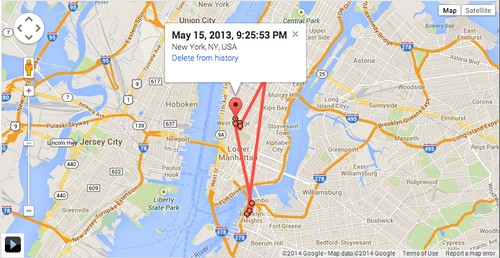HACKED: Google Maps Has Been Tracking Your Every Move, And There’s A Website To Prove It ,...How to delete and disable your Google location history?
17 AUG 2014Google Maps Has Been Tracking Your Every Move, And There’s A Website To Prove It
Remember that scene in Minority Report, where Tom Cruise is on the run from the law, but is unable to avoid detection because everywhere he goes there are constant retina scans feeding his location back to a central database? That’s tomorrow. Today, Google is tracking wherever your smartphone goes, and putting a neat red dot on a map to mark the occasion.You can find that map here. OR https://maps.google.com/locationhistory/b/0/ All you need to do is log in with the same account you use on your phone, and the record of everywhere you’ve been for the last day to month will erupt across your screen like chicken pox.
 We all know that no matter what ‘privacy’ settings you may try and
implement, our information is all being collected and stored somewhere.
That knowledge sits in the back of our minds, and is easy to drown out
by shoving in some headphones and watching Adventure Time on repeat until everything stops being 1984. But
it’s a sharp jolt back to reality when you see a two dimensional image
marking your daily commute with occasional detours to the cinema or a
friend’s house.
We all know that no matter what ‘privacy’ settings you may try and
implement, our information is all being collected and stored somewhere.
That knowledge sits in the back of our minds, and is easy to drown out
by shoving in some headphones and watching Adventure Time on repeat until everything stops being 1984. But
it’s a sharp jolt back to reality when you see a two dimensional image
marking your daily commute with occasional detours to the cinema or a
friend’s house.Looking at mine, I realised that a) I live my life in a very small radius, and b) there are places on my map that I don’t remember going. One of them I’ve apparently visited three times on different days. Once whilst “Biking” and twice while “Stationary”. All at times I wouldn’t usually be awake. I’m not sure what’s happening on Wood Street in North Melbourne, or why my phone apparently travels there without me, but I’m not going to rule out secret alien conspiracies.
Apparently this record only happens if you have ‘location
services’ switched on in your phone; if you do and you’re finding you
have no data, then it means that either you don’t exist or you’ve beaten
the system. If it’s the latter, please teach me your ways; I know for a
fact that I switched my phone’s location detection off, but apparently
it somehow got switched back on.

(iStockphoto)
You likely know that when you
search for directions using Google Maps, the service registers where you
are to help get you from Point A to Point B. But did you know that the
app regularly tracks and archives your location in an entirely separate
database?
Yes, Apple isn’t the only one quietly filing away your location data. Google
has its own comprehensive treasure trove of your information, which
tracks and time-stamps your approximate location, ranging back months
and months.
To see your history, you first
need to log in to Google. Keep in mind that, if you’ve never logged in
to the Maps tool while using it before, this will likely not apply.
Once you’re logged in, visit this link. OR https://maps.google.com/locationhistory/b/0/ You’ll
be able to see pretty much everywhere you’ve been within the past year,
day by day. It varies from person to person. I, for instance, have a
history that dates back to May 15, 2013. A reader of mine, who tipped me
off to this page, says his account shows 14 months’ worth of locations.

My approximate locations from May 15, 2013.

Where I went that entire month.
To the left of the map, below a calendar tool, is an option called Show timestamps.

Click the arrow, and it will show
a range of times. Clicking on a particular time will bring it up on the
map, pinpointing where you were during that time period.

So you can see that at 9:25 p.m., I was somewhere around the West Village. Let’s all take a moment to recognize how painfully chic I am.

I have nothing to hide here, but
sometimes people lie about where they are. Whether or not it’s right,
it’s entirely human. This Google Maps data throws a wrench in that
scheme.
That being said, this stuff is
not being publicly displayed anywhere. The dashboard, as Google puts it,
is meant to highlight “useful or interesting information from your
existing location history.” I’ve reached out for comment about how the
company might otherwise use this information.
If you want to clear parts of
this history, you can select specific time periods on the calendar to
the left of the map and click Delete history from this day. Or, if you want a fresh start, click Delete all history.

To disable this feature completely, go to the box labeled with a tool icon in the upper-right corner of the page.

Select History settings.

Select Disable, and then click Save.

And
now you’ve wiped yet another tech company’s database of information you
never really knew it had. Good job. Go ahead and take the rest of the
day off. There’s likely more to come.
How to delete and disable your Google location history
Google can track your location and show you on Google Maps and Google Earth where you have been recently, which you may find useful, interesting, or invasive. Here's how to see if you have location history turned on and how to disable it.Disabling location history, however, does not remove your past history. If you'd like to erase the locations Google has stored for the past 30 days, head back to the Location history page. The default time period shows location history for the current day, so you may not see any plots on the map.
Use the pull-down menu below the calendar on the left to show your history, up to 30 days. If you choose a time period in which Google has tracked your location, you'll see the points where you've been on the map. And below the calendar, you'll see options to delete your history from the time period you have chosen or to delete all history.
For iOS users who want to disable Google from using location services, follow this path: Settings > Privacy > Location Services, and turn the slider switch off for Google Maps. For Android users looking to prevent Google from using location service on their mobile device, this Google Support page has instructions.



